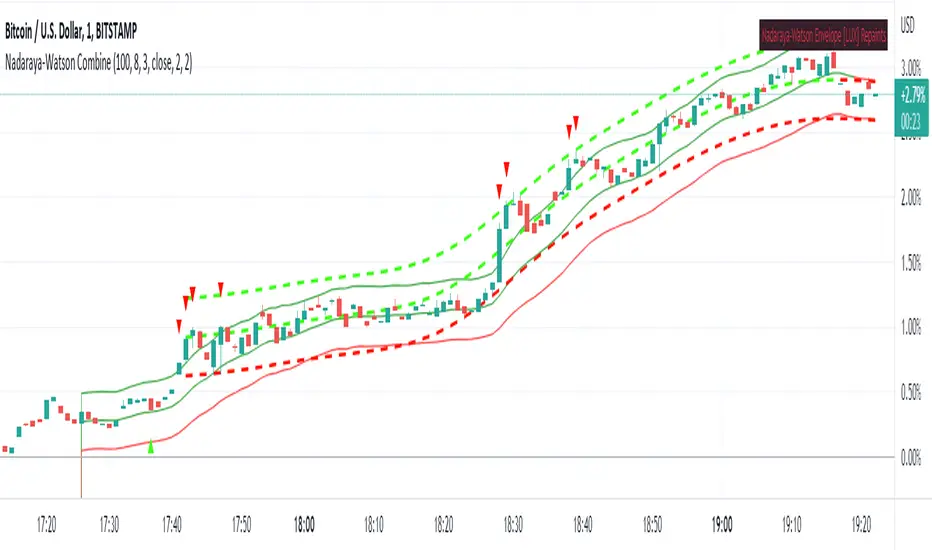OPEN-SOURCE SCRIPT
Nadaraya-Watson Combine

This is a combination of the Lux Algo Nadaraya-Watson Estimator and Envelope. Please note the repainting issue.
In addition, I've added a plot of the actual values of the current barstate of
the Nadaraya-Watson windows as they are computed (lines 92-95). It only plots values for the current data at
each time update. It is interesting to compare the trajectory of the end points of the Estimator and
Envelope to the smoothing function at each time update. Due to the kernel smoothing at each update the
history is lost at each update (repaint).
I've added a feature to allow adjustment to the kernel smoothing algorithm as suggested by thomsonraja (line 59).
The settings and usage are repeated from Lux Algo below.
Settings
Window Size: Determines the number of recent price observations to be used to fit the Nadaraya-Watson Estimator.
Bandwidth: Controls the degree of smoothness of the envelopes , with higher values returning smoother results.
Mult: Controls the envelope width.
Src: Input source of the indicator.
Kernel power: See line 59, adjusts the exponential power (powh) as suggested by thomsonraja
Kernel denominator: See line 59, adjusts the denominator (den) as suggested by thomsonraja
Usage
This tool outlines extremes made by the prices within the selected window size.
This is achieved by estimating the underlying trend in the price using kernel smoothing,
calculating the mean absolute deviations from it, and adding/subtracting it
from the estimated underlying trend.
I repeat Lux Algo's caution: 'we do not recommend this tool to be used alone
or solely for real time applications.'
In addition, I've added a plot of the actual values of the current barstate of
the Nadaraya-Watson windows as they are computed (lines 92-95). It only plots values for the current data at
each time update. It is interesting to compare the trajectory of the end points of the Estimator and
Envelope to the smoothing function at each time update. Due to the kernel smoothing at each update the
history is lost at each update (repaint).
I've added a feature to allow adjustment to the kernel smoothing algorithm as suggested by thomsonraja (line 59).
The settings and usage are repeated from Lux Algo below.
Settings
Window Size: Determines the number of recent price observations to be used to fit the Nadaraya-Watson Estimator.
Bandwidth: Controls the degree of smoothness of the envelopes , with higher values returning smoother results.
Mult: Controls the envelope width.
Src: Input source of the indicator.
Kernel power: See line 59, adjusts the exponential power (powh) as suggested by thomsonraja
Kernel denominator: See line 59, adjusts the denominator (den) as suggested by thomsonraja
Usage
This tool outlines extremes made by the prices within the selected window size.
This is achieved by estimating the underlying trend in the price using kernel smoothing,
calculating the mean absolute deviations from it, and adding/subtracting it
from the estimated underlying trend.
I repeat Lux Algo's caution: 'we do not recommend this tool to be used alone
or solely for real time applications.'
Skrypt open-source
W zgodzie z duchem TradingView twórca tego skryptu udostępnił go jako open-source, aby użytkownicy mogli przejrzeć i zweryfikować jego działanie. Ukłony dla autora. Korzystanie jest bezpłatne, jednak ponowna publikacja kodu podlega naszym Zasadom serwisu.
Wyłączenie odpowiedzialności
Informacje i publikacje nie stanowią i nie powinny być traktowane jako porady finansowe, inwestycyjne, tradingowe ani jakiekolwiek inne rekomendacje dostarczane lub zatwierdzone przez TradingView. Więcej informacji znajduje się w Warunkach użytkowania.
Skrypt open-source
W zgodzie z duchem TradingView twórca tego skryptu udostępnił go jako open-source, aby użytkownicy mogli przejrzeć i zweryfikować jego działanie. Ukłony dla autora. Korzystanie jest bezpłatne, jednak ponowna publikacja kodu podlega naszym Zasadom serwisu.
Wyłączenie odpowiedzialności
Informacje i publikacje nie stanowią i nie powinny być traktowane jako porady finansowe, inwestycyjne, tradingowe ani jakiekolwiek inne rekomendacje dostarczane lub zatwierdzone przez TradingView. Więcej informacji znajduje się w Warunkach użytkowania.